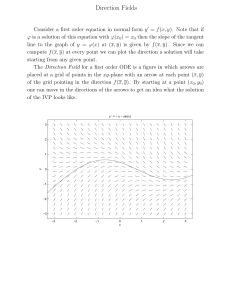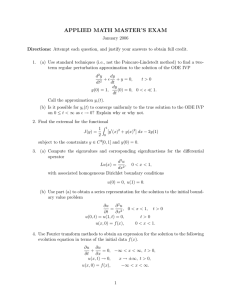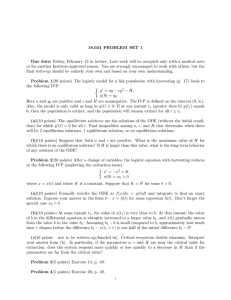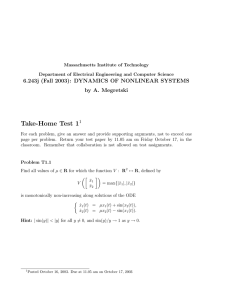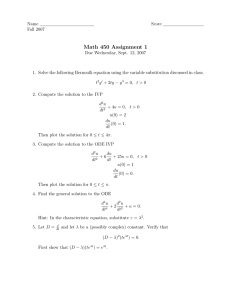18.034 SOLUTIONS TO PROBLEM SET ... Due date: Friday, February 13 ...
advertisement
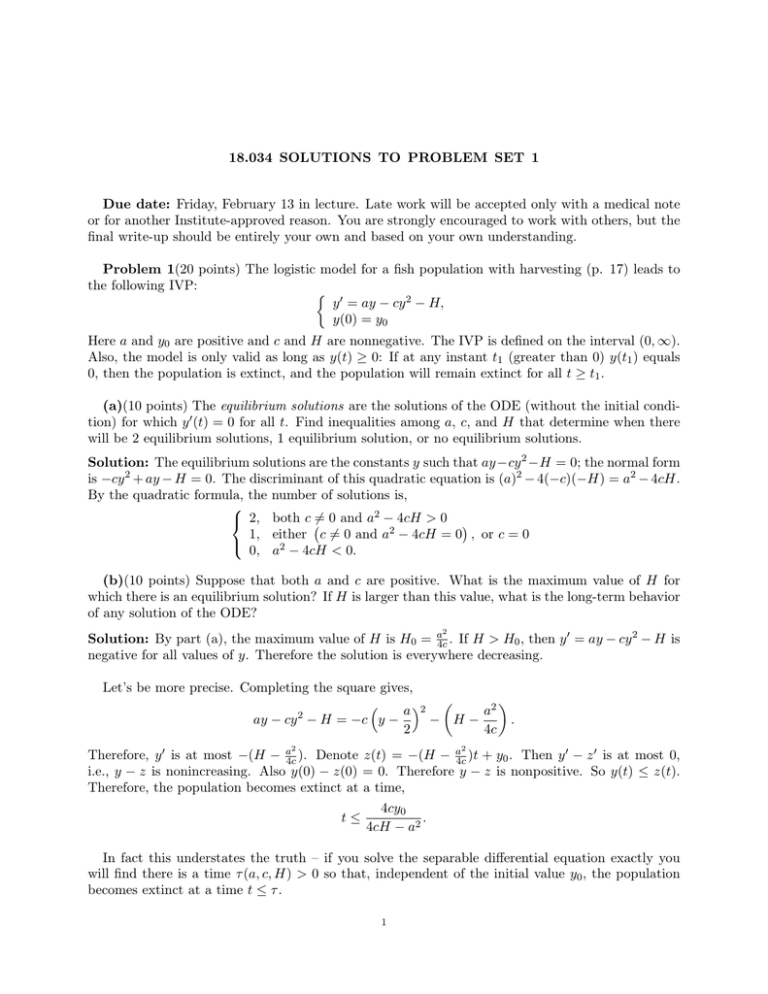
18.034 SOLUTIONS TO PROBLEM SET 1 Due date: Friday, February 13 in lecture. Late work will be accepted only with a medical note or for another Institute­approved reason. You are strongly encouraged to work with others, but the final write­up should be entirely your own and based on your own understanding. Problem 1(20 points) The logistic model for a fish population with harvesting (p. 17) leads to the following IVP: � � y = ay − cy 2 − H, y(0) = y0 Here a and y0 are positive and c and H are nonnegative. The IVP is defined on the interval (0, ∞). Also, the model is only valid as long as y(t) ≥ 0: If at any instant t1 (greater than 0) y(t1 ) equals 0, then the population is extinct, and the population will remain extinct for all t ≥ t1 . (a)(10 points) The equilibrium solutions are the solutions of the ODE (without the initial condi­ tion) for which y � (t) = 0 for all t. Find inequalities among a, c, and H that determine when there will be 2 equilibrium solutions, 1 equilibrium solution, or no equilibrium solutions. Solution: The equilibrium solutions are the constants y such that ay−cy 2 −H = 0; the normal form is −cy 2 + ay − H = 0. The discriminant of this quadratic equation is (a)2 − 4(−c)(−H) = a2 − 4cH. By the quadratic formula, the number of solutions is, ⎧ ⎨ 2, both c ��= 0 and a2 − 4cH > 0 � � 0 and a2 − 4cH = 0 , or c = 0 1, either c = ⎩ 2 0, a − 4cH < 0. (b)(10 points) Suppose that both a and c are positive. What is the maximum value of H for which there is an equilibrium solution? If H is larger than this value, what is the long­term behavior of any solution of the ODE? 2 Solution: By part (a), the maximum value of H is H0 = a4c . If H > H0 , then y � = ay − cy 2 − H is negative for all values of y. Therefore the solution is everywhere decreasing. Let’s be more precise. Completing the square gives, � � � a �2 a2 2 . ay − cy − H = −c y − − H− 2 4c 2 2 Therefore, y � is at most −(H − a4c ). Denote z(t) = −(H − a4c )t + y0 . Then y � − z � is at most 0, i.e., y − z is nonincreasing. Also y(0) − z(0) = 0. Therefore y − z is nonpositive. So y(t) ≤ z(t). Therefore, the population becomes extinct at a time, 4cy0 t≤ . 4cH − a2 In fact this understates the truth – if you solve the separable differential equation exactly you will find there is a time τ (a, c, H) > 0 so that, independent of the initial value y0 , the population becomes extinct at a time t ≤ τ . 1 Problem 2(20 points) After a change of variables, the logistic equation with harvesting reduces to the following IVP (neglecting the extinction issue), � � x = −x2 + K, x(0) = x0 > 0 where x = x(t) and where K is a constant. Suppose that K = b2 for some b > 0. (a)(10 points) Formally rewrite the ODE as f (x)dx = g(t)dt and integrate to find an exact solution. Express your answer in the form b − x = h(t) for some expresion h(t). Don’t forget the special case x0 = b. The ODE separates as, � 1 dx = 2 b − x2 � dt. By partial fractions, this is the same as, � � � � 1 1 + dx = 2bdt. b+x b−x Antidifferentiating, � ln b+x b−x � = 2bt + C. Exponentiating, b+x = A� e2bt , b−x or equivalently, b−x = Ae−2bt . b+x Rewriting b + x = 2b − (b − x), and solving for b − x gives, b − x(t) = 2bAe−2bt . 1 + Ae−2bt 0 If x0 = � b, define a new parameter α = b−x 2b . Then, solving in terms of α, � � � 1 , x0 �= b, (b − x0 )e−2bt (1−α)+αe −2bt (b − x(t)) = 0, x0 = b. (b)(10 points) At some instant t1 , the value of x(t1 ) is very close to b. At that instant, the value of b in the differential equation is abruptly increased to a larger value b1 , and x(t) gradually moves from the value b to the value b1 . Assuming b1 − b is small compared to b, approximately how much time τ elapses before the difference b1 − x(t1 + τ ) is one half of the initial difference b1 − b? Solution: To simplify the problem, change coordinates in t so that t1 = 0. Because the ODE is autonomous, this doesn’t change the ODE (this will be the key to analyzing solutions of autonomous ODEs later on). Let x0 = x(t1 ). Then the solution of the IVP with b1 has the form, � � 1 −2b1 t (b1 − x(t)) = (b1 − x0 )e , (1 − α1 ) + α1 e−2b1 t where α1 = b−x0 2b . 2 By hypothesis, α ≈ 0. Therefore the third factor in the solution is approximately 1, and the solution of the IVP is approximately a decreasing exponential, (b1 − x(t)) ≈ (b1 − x0 )e−2b1 t . So the half­life is τ≈ ln(2) . 2b1 (c)(0 points – not to be written up/handed in). Critical ecosystem double whammy. Interpret your answer from (b). In particular, if the parameters a, c and H are near the critical value for extinction, does the system respond more quickly or less quickly to a decrease in H than if the parameters are far from the critical value? Solution: This part was not to be handed in. The “solution” is only given for fun. The change of variables necessary to put the ODE in standard form is, � � � x =� c y − a2 , 2 b = a4 − cH. So if a, c and H are near the critical value, then b is near 0. Decreasing H while holding a and c fixed increases b to a new value b1 . By (b), the half­life, or “reaction time”, of the system to this change is proportional to 1 1 ≈ . b b1 So when b is small, the reaction time is large. This is the “double whammy”: not only is the population close to the critical value of extinction (so a natural disaster, etc. could easily drive the population to extinction), but also a positive change in the environment (for instance, a government ban on fishing in a certain area) takes a long time to have a positive impact on the population. Problem 3(5 points) Exercise 14, p. 49. Solution: It is easier to spot the integrating factor without putting the ODE in normal form. For any ODE of the form, ty � + ay = q(t), t ≥ 0, an integrating factor is clearly u(t) = ta−1 , (ta y)� = ta−1 q(t). In this case, antidifferentiating both sides, t2 y(t) = � 1 t3 dt = t4 + C. 4 So the general solution is, 1 C y(t) = t2 + 2 , t ≥ 0. 4 t The qualitative behavior as t → 0+ depends on the constant C. If C > 0, then y(t) diverges to . +∞ as t12 . If C = 0, then y(t) converges to 0 as t2 . If C < 0, then y(t) diverges to −∞ as −1 t2 The qualitative behavior as t → ∞ is the same for all solutions: the graph of y(t) converges to the graph of the steady­state solution, 41 t2 . In particular it diverges to ∞ as t2 . Problem 4(5 points) Exercise 20, p. 49. 3 As above, the integrating factor is easier to “eyeball” than to deduce formally. Multiplying both sides of the equation by sin t gives, (sin t)y � + (cos t)y = 2(sin t)(cos t), y(3π/4) = 2. This is the same as, (sin(t)y)� = (sin(t)2 )� , y(3π/4) = 2. Antidifferentiating, the general solution is, sin(t)y = sin(t)2 + C. Solving the initial condition, C = −3. So the solution of the IVP is, y(t) = sin(t) − 3 csc(t). Because sin(t) → 0 like t as t → 0+ , y(t) diverges to −∞ like 4 −1 t as t → 0+ .


